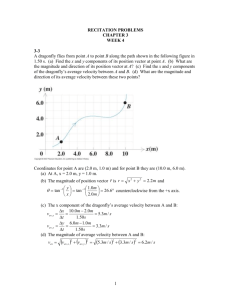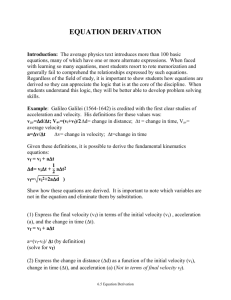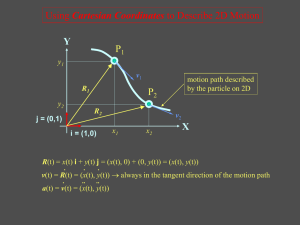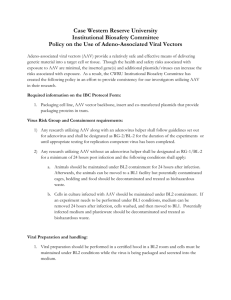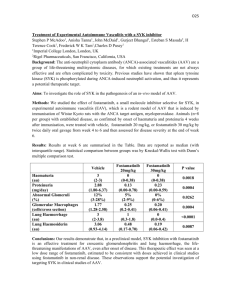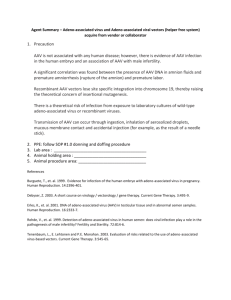1D Kinematics Problem Set: Displacement, Velocity, Acceleration
advertisement
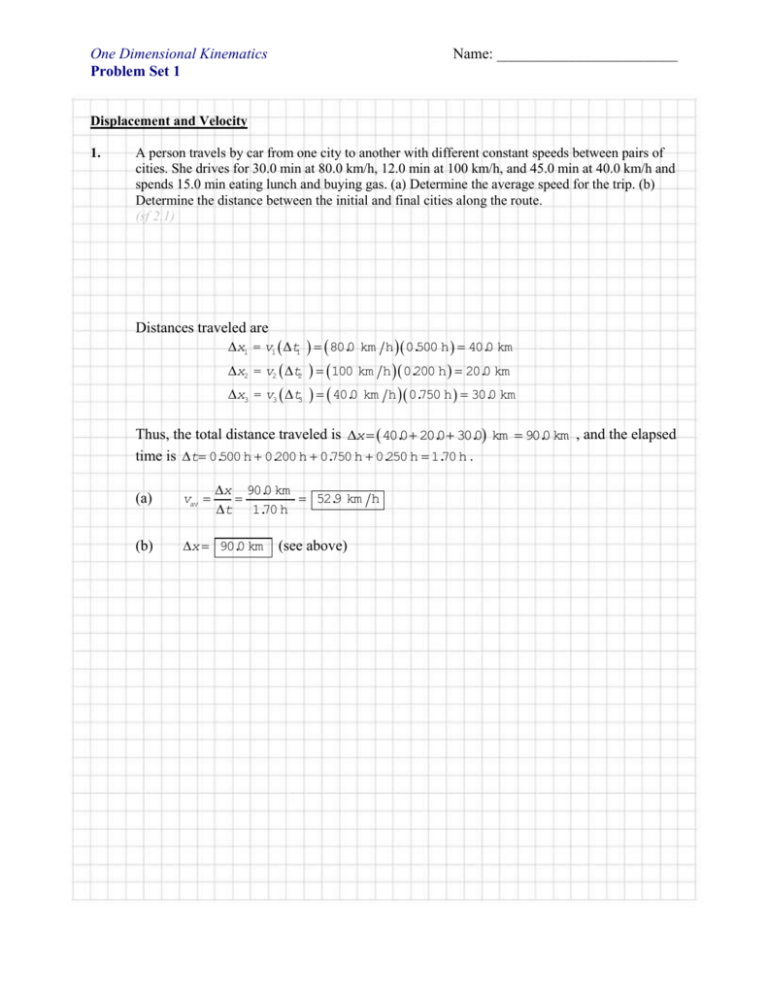
One Dimensional Kinematics Problem Set 1 Name: ________________________ Displacement and Velocity 1. A person travels by car from one city to another with different constant speeds between pairs of cities. She drives for 30.0 min at 80.0 km/h, 12.0 min at 100 km/h, and 45.0 min at 40.0 km/h and spends 15.0 min eating lunch and buying gas. (a) Determine the average speed for the trip. (b) Determine the distance between the initial and final cities along the route. (sf 2.1) Distances traveled are x1 = v1 t1 80.0 km h 0.500 h 40.0 km x2 = v2 t2 100 km h 0.200 h 20.0 km x3 = v3 t3 40.0 km h 0.750 h 30.0 km Thus, the total distance traveled is x 40.0 20.0 30.0 km 90.0 km , and the elapsed time is t 0.500 h 0.200 h 0.750 h 0.250 h 1.70 h . x 90.0 km 52.9 km h t 1.70 h (a) vav (b) x 90.0 km (see above) One Dimensional Kinematics Problem Set 1 2. Name: ________________________ A motorist drives north for 35.0 minutes at 85.0 km/h and then stops for 15.0 minutes. He then continues north, traveling 130 km in 2.00 h. (a) What is his total displacement? (b) What is his average velocity? (sf 2.5) (a) 35.0 D isplacem ent 85.0 km h h 130 km 60.0 x 49.6 130 km 180 km (b) A verage velocity D isplacem ent 49.6 130 km 63.4 km h elapsed tim e 35.0 15.0 2.00 h 60.0 One Dimensional Kinematics Problem Set 1 3. Name: ________________________ A tennis player moves in a straight-line path as shown. Find her average velocity in the time intervals from (a) 0 to 1.0 s, (b) 0 to 4.0 s, (c) 1.0 s to 5.0 s, and (d) 0 to 5.0 s. (sf 2.7) (a) vav (b) vav (c) vav (d) vav x 4.0 m 0 4.0 m s t 1.0 s 0 x 2.0 m 0 0.50 m s t 4.0 s 0 x 0 4.0 m 1.0 m s t 5.0 s 1.0 s x 0 0 0 t 5.0 s 0 4. A tortoise can run with a speed of 0.10 m/s, and a hare can run 20 times as fast. In a race, they both start at the same time, but the hare stops to rest for 2.0 minutes. The tortoise wins by a shell (20 cm). (a) How long does the race take? (b) What is the length of the race? (sf 2.12) (a) At the end of the race, the tortoise has been moving for time t and the hare for a time t 2.0 m in t 120 s. The speed of the tortoise is vt 0.100 m s , and the speed of the hare is vh 20vt 2.0 m s. The tortoise travels distance xt , which is 0.20 m larger than the distance xh traveled by the hare. Hence, xt xh 0.20 m , which becomes vt t vh t 120 s 0.20 m or 0.100 m s t 2.0 m s t 120 s 0.20 m This gives the time of the race as t 1.3 102 s (b) xt vtt 0.100 m s 1.3 102 s 13 m 5. Runner A is initially 4.0 mi west of a flagpole and is running with a constant velocity of 6.0 mi/h due east. Runner B is initially 3.0 mi east of the flagpole and is running with a constant velocity of 5.0 mi/h due west. How far are the runners from the flagpole when they meet? (sf 2.14) Choose a coordinate axis with the origin at the flagpole and east as the positive direction. Then, using x x0 v0t 12 at2 with a 0 for each runner, the x-coordinate of each runner at time t is xA 4.0 m i 6.0 m ih t and xB 3.0 m i 5.0 m ih t When the runners meet, xA xB or 4.0 m i 6.0 m ih t 3.0 m i 5.0 m ih t This gives the elapsed time when they meet as t 7.0 m i 0.64 h . At this time, 11.0 m ih xA xB 0.18 m i. Thus, they meet 0.18 m iw estofthe flagpole 6. Find the instantaneous velocities of the tennis player of problem 3 at (a) 0.50 s, (b) 2.0 s, (c) 3.0 s, and (d) 4.5 s. (sf 2.17) (a) v 0.50 s (b) v 2.0 s (c) v 3.0 s (d) v 4.5 s x 1.0 s x t0 1.0 s 0 x 2.5 s x 1.0 s 2.5 s 1.0 s x 4.0 s x 2.5 s 4.0 m 4.0 m s 1.0 s 6.0 m 4.0 m s 1.5 s 0 0 4.0 s 2.5 s 1.5 s x 5.0 s x 4.0 s 5.0 s 4.0 s 2.0 m 2.0 m s 1.0 s Constant Acceleration 7. A steam catapult launches a jet aircraft from the aircraft carrier John C. Stennis, giving it a speed of 175 mi/h in 2.50 s. (a) Find the average acceleration of the plane. (b) Assuming that the acceleration is constant, find the distance the plane moves. (sf 2.19) (a) aav or v 175m ih 0 70.0 m ih s t 2.5 s m i 1609 m 1 h 2 aav 70.0 31.3 m s h s 1 m i 3600 s Alternatively, 1g m aav 31.3 2 3.19 g 2 s 9.80 m s (b) If the acceleration is constant, x v0t 12 at2 m 2 x 0 12 31.3 2 2.50 s 97.8 m s or 3.281 ft x 97.8 m 321 ft 1m 8. A certain car is capable of accelerating at a rate of +0.60 m/s2. How long does it take for this car to go from a speed of 55 mi/h to a speed of 60 mi/h? (sf 2.21) From a v v 60 55 m ih 0.447 m s , we have t 3.7 s t a 0.60 m s2 1 m ih 9. The velocity vs. time graph for an object moving along a straight path is shown in Figure P2.22. (a) Find the average acceleration of the object during the time intervals 0 to 5.0 s, 5.0 s to 15 s, and 0 to 20 s. (b) Find the instantaneous acceleration at 2.0 s, 10 s, and 18 s. (sf 2.22) (a) From t 0 to t 5.0 s, aav v v0 0 0 0 t t0 5.0 s 0 From t 5.0 s to t 15 s , aav 8.0 m s 8.0 m s 15 s 5.0 s and from t 0 to t 20 s, aav 8.0 m s 8.0 m s 20 s 0 1.6 m s2 0.80 m s2 (b) At t 2.0 s, the slope of the tangent line to the curve is 0 . At t 10 s , the slope of the tangent line is 1.6 m s2 , and at t 18 s , the slope of the tangent line is 0 . 10. The engine of a model rocket accelerates the rocket vertically upward for 2.0 s as follows: At t = 0, the rocket’s speed is zero; at t = 1.0 s, its speed is 5.0 m/s; and at t = 2.0 s, its speed is 16 m/s. Plot a velocity vs. time graph for this motion, and use the graph to determine (a) the rocket’s average acceleration during the 2.0-s interval and (b) the instantaneous acceleration of the rocket at t = 1.5 s. (a) The average acceleration can be found from the curve, and its value will be v 16 m s aav 8.0 m s2 t 2.0 s (b) The instantaneous acceleration at t 1.5 s equals the slope of the tangent line to the curve at that time. This slope is about 12 m s2 . Note: Sep 7,2010 Re write problem for next year so that it includes more data points to graph.

